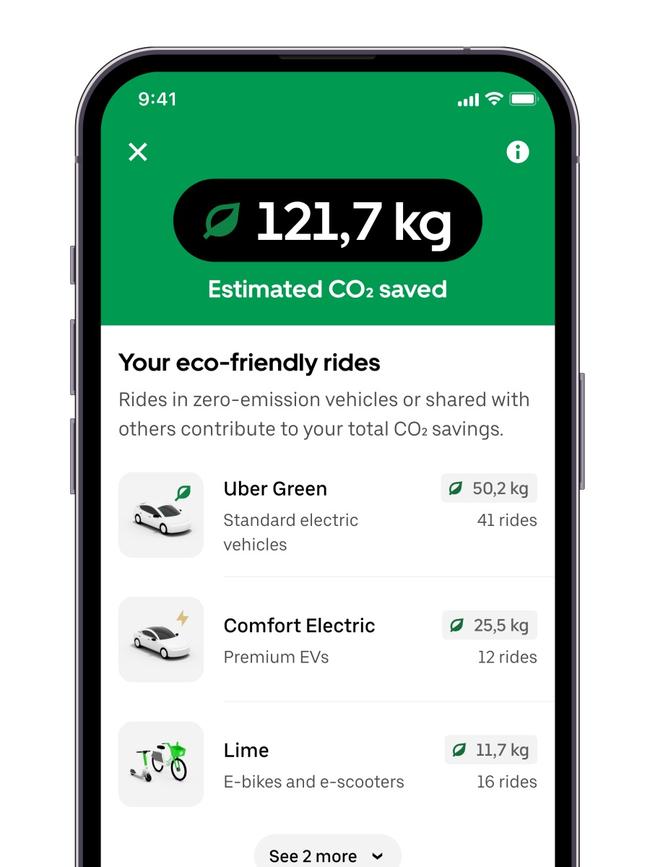Uber expands electric rideshare offer amid sustainability push
From April 2025, Uber Green will be exclusively serviced by EVs. It marks Uber’s second fully electric offering in Australia, following the launch of Comfort Electric earlier this year.

Uber has accelerated its global sustainability ambitions with a series of local initiatives aimed at reshaping how Australians travel – offering riders greener transport options, enabled by helping drivers and delivery people transition to electric vehicles.
In 2020, Uber pledged to eliminate vehicle emissions across its core mobility business by 2040, and last year it extended this commitment to include its delivery service Uber Eats, according to Emma Foley, managing director for Uber Australia and New Zealand.
“Ever since, we’ve been investing heavily in initiatives and partnerships in Australia designed to bring down costs of owning electric vehicles for our driver partners and delivery people,” Foley says.
“We know that the purchase costs of EVs are the biggest barriers to going electric, and therefore getting that cost down has been our primary focus for the past three years.”
Uber Australia’s latest initiative for riders is to transition its Green product – which currently matches riders with low or zero-emission trips in a hybrid or EV – to a fully electric service. This means hybrids will be phased out, and from April 2025 Uber Green will be exclusively serviced by EVs. It marks Uber’s second fully electric offering in Australia, following the launch of Comfort Electric earlier this year. However, unlike Comfort Electric, a premium experience featuring more spacious EVs, Green will remain priced on par with Uber X and include a broader range of eligible EV models.
“We know Aussies are increasingly conscious of their environmental footprint and are looking for ways to make small, but impactful changes in their everyday lives,” Foley says.
“Transitioning Uber Green to an EV-only product will give local riders even more choice when it comes to making more sustainable choices with the Uber platform. That’s why we’re excited that from April next year, for the same price as Uber X, riders will be guaranteed an emissions-free trip when they choose Uber Green.”
Uber’s journey in Australia towards net zero has accelerated since its 2020 pledge to eliminate tailpipe emissions by 2040. In 2022, Uber expanded support for its drivers with a $26m investment in service fee discounts and partnered with vehicle subscription service Splend to improve access to EVs. In 2023, Uber launched Uber Green in Australia (including hybrids and EV), established a charging partnership with BP Pulse, introduced at-home charging solutions through EVSE and teamed up with EVDirect to bring 10,000 BYD EVs to the country.

The latest step in Uber’s local sustainability journey, with Uber Green becoming an EV-only service, will place Australian cities among more than 40 cities worldwide where Uber Green is fully electric, out of more than 200 cities globally where the product is currently available.
Uber’s usage data highlights the growing popularity of EVs on its platform. EVs now account for more than 5 per cent of all kilometres driven on the platform, a notable increase since Uber began its electrification efforts in 2021. Despite this progress, the company acknowledges there is still significant work ahead to achieve its zero-emissions target.
“We’ve seen EV uptake on our platform outpace that of Australia’s general population by four to one,” Foley says.
“We take our responsibility as part of the wider Australian transport ecosystem seriously, especially because an EV on a rideshare platform can have an outsized impact on emissions reduction. Rideshare EVs realise four to five times the emissions savings compared to a vehicle that’s only driven privately.”
Uber has also enhanced transparency for Australian riders regarding their environmental impact by introducing the Emission Savings app feature earlier this year. It provides riders with insights into the emissions they have avoided by selecting lower-emission ride options. Emission savings are calculated as the difference in CO2 emitted between low-emission ride options on the Uber app and their standard-emission counterparts.

To support growing demand for electric rides, Uber is also focused on increasing access to EVs for its driver partners. In August, the company launched a partnership with pre-owned electric vehicle dealership Car Empire to offer affordable second-hand EVs to drivers in Brisbane and the Gold Coast. The pilot scheme, based on Nissan Leaf EVs, has already seen strong uptake, prompting Uber to expand the program to include additional models and regions.
“Drivers consistently tell us the upfront costs of an EV is the biggest barrier to making the switch from a petrol vehicle,” Foley says.
“For the past three years, we’ve taken a number of steps to bring these costs down, from halving our service fee for EV drivers, to discount partnerships with vehicle distributors and charging providers.”
Uber’s partnership with vehicle subscription company Splend is another key part of its strategy. Together, they are working to bring more EVs onto the platform, with competitive offers on both new and pre-owned EVs. This includes 200 additional second-hand EVs available to drivers across Sydney, Melbourne, Perth, Adelaide, Brisbane and Canberra.
“We’ve always believed a thriving second-hand EV marketplace would be a key catalyst to accelerate adoption across our platform, and we’re thrilled to have partnered with Car Empire and Splend to make a number of compelling offers on pre-owned EVs available to our drivers directly,” Foley says.
“Not only are they better for the environment, but the running costs of an EV are much lower than that of a petrol car.
“Charging costs less than filling up with petrol, and maintenance costs are consistently lower. We also hear from riders that they enjoy the experience of taking a trip in an EV, which in turn generates more demand for EV trips on the platform.”


